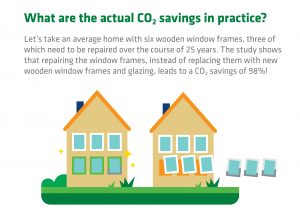Research shows that repairing window frames is up to 90% more environmentally friendly than replacement
Wood rot in window frames; homeowners may have to deal with this sooner or later when dealing with poorly manufactured or poorly maintained windows, and when they do, they often tend to consider replacement first. However, as it turns out, replacement is not the best solution for the environment. A study conducted at CE Delft has shown that repairing window frames is a much more environmentally friendly option across its life span. The ‘gain’ in CO2 emission reductions can be as high as 90% or more.
CE Delft, an independent research and consultancy agency specialising in sustainability issues, researched the difference in CO2 impact between repairing and replacing wooden window frames. Researcher Maarten Bruinsma from CE Delft states that there are clear results: ‘In terms of environmental impact, repairing damaged window frames scores two to five times better than replacing them with new window frames. Even when the window frame needs extensive repairs at several points, it’s still the best option. In a scenario when the glass in the existing frame doesn’t need to be replaced, repairing scores 9 to 27 times better than replacement.’
Using resources more consciously
Repair Care commissioned the study, Mark Gosens the Product Developer at Repair Care, explains why they decided to do so. ‘Everyone realises by now that we need to be more conscious of how we use our resources. Many of us – ourselves included – were already convinced that repairing wood rot and damaged timber would be better for the environment than replacement. However, we also wanted to prove this objectively. As a market leader, we took up the gauntlet together with an independent research and consultancy agency. Wood rot mostly forms in the bottom part of the frame, which means that even the most adversely affected frames are still largely comprised of healthy timber. CE Delft has provided us with written proof that repairing these frames is better for the environment.’
Life cycle analysis
The study used the LCA method, where the entire product life cycle is used to evaluate the environmental impact of a product. ‘We use a cradle-to-grave approach, from the raw materials used to make the product to the final disposal of the materials,’ Maarten Bruinsma explains. Repair Care’s products – pure epoxy repair materials – and their performance were used as a starting point. Other repair materials, such as polyester resins or impure epoxy-based materials, do not achieve the same level of sustainability. The study was conducted following European Standards.
A uPVC window frame has the biggest carbon footprint
What do repairs provide in terms of actual CO2 savings? ‘A surprising amount,’ Mark Gosens explains, illustrating this with a practical example.

‘Let’s take an average home in the Netherlands with six wooden window frames, three of which need to be repaired over the course of 25 years*. The alternative is replacing these damaged window frames with new wooden ones, including new glazing. In such a situation, repairing frames can reduce CO2 emissions by up to 584 kg CO2 eq. (or 98%) compared to replacement. Such savings amount to the equivalent of CO2 emissions from driving 2865 km with a petrol-powered car, watching television non-stop for 18 months, or the electricity consumption of an average household over six months.’ The savings are even greater when you compare this to replacing the frames with aluminium or uPVC frames because those materials have a higher carbon footprint than wooden frames.

Reducing the carbon impact starts in people’s homes
Repair Care has responded enthusiastically to the study results. ‘The results are even more favourable than we initially thought,’ Mark Gosens says. ‘Repairing frames is not only good for your wallet but also much better for the environment. Maintenance companies and property managers are looking for more environmentally-friendly alternatives when restoring or renovating their homes. This study has led to new insights, but also solutions for restoring a facade while limiting the environmental impact.’
*=based on experiences with thousands of projects in the Netherlands, Germany, and the United Kingdom inspected and repaired by Repair Care.